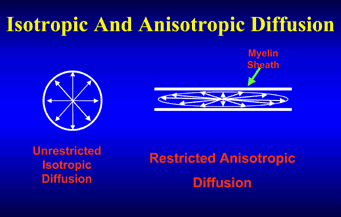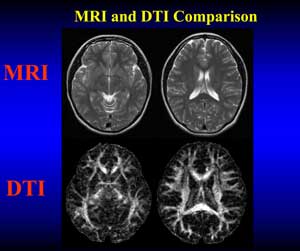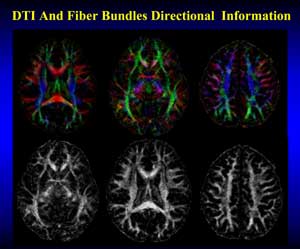RSNA Press Release
- Adolescents with early-onset schizophrenia show abnormalities in the white matter of the frontal lobe of the brain.
- Diffusion tensor imaging (DTI) can identify damage in the white-matter fiber tracts.
- In patients with early-onset schizophrenia, the cells that control information transmission are defective.
Faulty Wiring in the Brain May Cause Early-Onset Schizophrenia
Released: December 2, 2003
|
Media Contacts: |
Heather Babiar or Maureen Morley | (630) 590-7762 |
|
Heather Babiar (630) 590-7738 hbabiar@rsna.org |
Maureen Morley (630) 590-7754 mmorley@rsna.org |
CHICAGO — Using diffusion tensor imaging (DTI) to look into the brains of children with schizophrenia, researchers have discovered abnormalities in the white matter of the frontal lobe that disrupt the transmission of signals regulating behavior, according to a study presented today at the 89th Scientific Assembly and Annual Meeting of the Radiological Society of North America (RSNA).
"Until now there's been no sophisticated method of finding abnormalities in the white matter of the brain," said the study's lead author Manzar Ashtari, Ph.D., associate professor of radiology and psychiatry at North Shore Long Island Jewish Health System and Albert Einstein College of Medicine in New York. "Conventional magnetic resonance (MR) imaging is limited in its ability to reveal brain myelination, but DTI enables us to measure the myelination process."
Myelin is the covering of nerve bundles that protects neurons and increases their transmission efficiency. The accumulation of myelin around these neurons is called myelination. In the human developmental process, myelination correlates with maturing patterns of behavior. In patients with schizophrenia, the cells that carry out the process of myelination are defective.
Myelination activity is at its strongest during the teen years. "This is a critical time for adolescents who are still maturing emotionally," Dr. Ashtari said. "During the myelination process, microstructural damage to developing white matter fiber tracts may lead to developmental abnormalities. These are the types of abnormalities we observed in the frontal white matter regions in the children with schizophrenia."
Dr. Ashtari and her team used DTI to study 12 adolescents with early-onset schizophrenia and nine healthy, age-matched adolescents. They found distinct differences in the white brain matter of the frontal lobe, which controls numerous emotional, cognitive and linguistic behaviors. When signals are disrupted, abnormal behaviors result. "It's a problem with connectivity," Dr. Ashtari said. "It's like the wiring in a house, only we are looking at the network of the brain — how the brain is wired."
Schizophrenia is a chronic and extremely disabling brain disease that affects one out of every 100 people in the United States. There is no cure.
According to Sanjiv Kumra, M.D., co-author of the study and research scientist at Zucker Hillside Hospital in New York, adolescents are diagnosed with schizophrenia if they meet two of the five criteria — hallucinations, delusions, thought disorder, bizarre behavior and negative symptoms (lack of motivation, loss of enjoyment in activities) — for at least six months and display deterioration of functioning. Children with schizophrenia are likely to exhibit developmental delay and language and emotional problems before the onset of psychotic symptoms.
DTI can identify white matter abnormalities before major symptoms are apparent. "Our goal is to detect and treat this disease early, so we can stop the progression before full-fledged symptoms develop," Dr. Ashtari said.
"Early-onset schizophrenia is especially disheartening because so many of these teens aren't diagnosed until they're adults," Dr. Kumra said. "Because these patients develop the disease at an early age when they have not yet built their lives, they tend to have a worse prognosis than those who have adult-onset schizophrenia."
Dr. Ashtari hopes that further DTI studies will yield more insight into the inner workings of schizophrenia. "If the malformation in the myelination process is the cause of schizophrenia, future special efforts can be focused in production of therapeutic agents that speed up or restart the myelination process," she said.
Co-authoring the study with Drs. Ashtari and Kumra are Marjorie McMeniman, Ph. D., Joshua Vogel, Alan Sloan Diamond, M.D., and Philip Szeszko, Ph.D.
RSNA is an association of more than 35,000 radiologists, radiation oncologists and related scientists committed to promoting excellence in radiology through education and by fostering research, with the ultimate goal of improving patient care. The Society is based in Oak Brook, Ill.
 |
|
 |
|
 |
View related abstract:
Diffusion Tensor Imaging of Patients with Early-onset Schizophrenia
# # #
 PDF
PDF